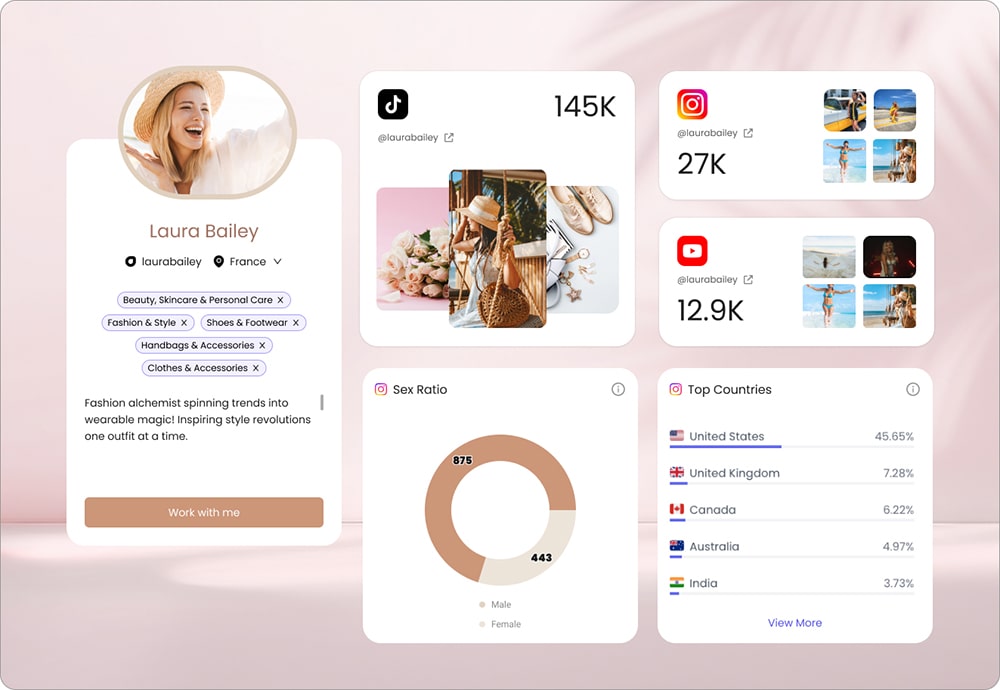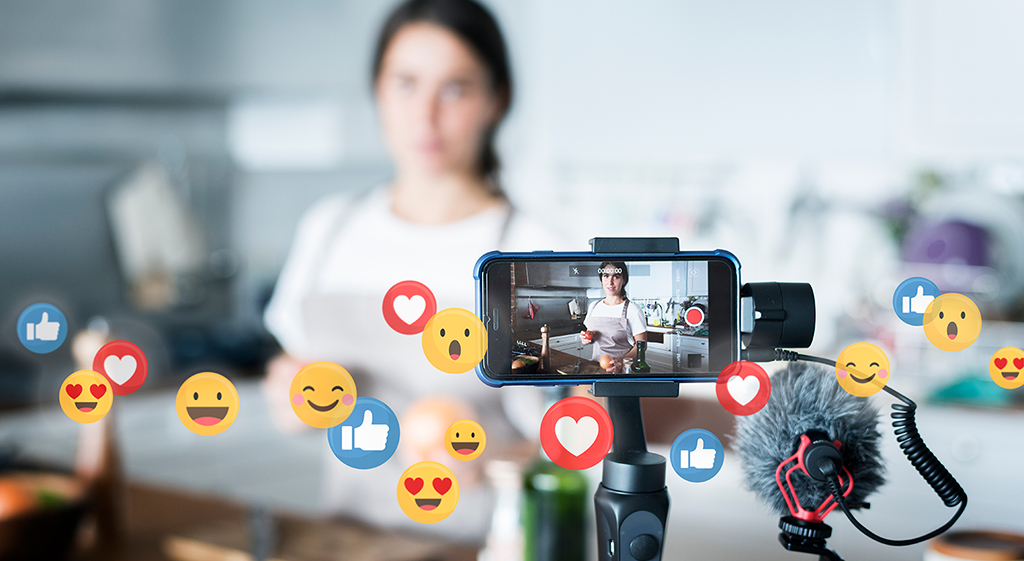If you’re wondering how to get brand deals, you’re at the right place! The influencer market is growing fast, and brands are always on the lookout for content creators who stand out. The best part? Influencer marketing has changed a lot in recent years. It’s not just about how many followers you have anymore—it’s about building a real community, understanding business, and connecting with brand values. Because of this shift, even creators with just a few thousand followers can now land brand deals and start earning steady income.
Getting started as an influencer and landing your first brand deal might seem overwhelming, but don’t worry! With the right steps, you can make it happen. This article will show you exactly how to get brand deals on Instagram, TikTok, and YouTube.
How do Brands Look for Influencers?
Ever wondered how brands pick content creators for collaborations? It might seem like a mystery – is it just the follower count, engagement rates, or creativity?
Well, the truth is, it’s a mix of factors that vary for each brand!
There are some things brands consider when choosing creators for brand deals. Here are a few of them:
- Relevance: Brands look for influencers whose content and niche align with their brand identity and values.
- Engagement and Reach: They analyze the influencer’s engagement rate, which includes likes, comments, and shares, as well as their total follower count.
- Authenticity and Credibility: Brands seek influencers who are authentic, genuine, and have built a sense of trust with their followers.
- Content Quality: They assess the influencer’s content to ensure it is of high quality, visually appealing, and aligns with the brand’s aesthetics and standards.
- Audience Demographics: Understanding the influencer’s audience demographics is crucial for brands to ensure they are reaching their target market effectively.
- Past Collaborations: Brands may look at the influencer’s history of brand collaborations and the success of previous campaigns.
- Brand Safety: Brands also consider whether the influencer has been involved in any controversies or situations that may negatively impact their brand’s reputation.
- Consistency: Brands evaluate how consistently and frequently the influencer posts content to ensure their audience remains engaged.
- Marketability and Personality: The influencer’s marketability and personality play a role in brands’ decision-making, as they want someone who can authentically represent their brand and resonate with the audience.
Through this thorough examination, brands find influencers who perfectly match their needs. This leads to partnerships that captivate their audience and leave a lasting impression.
Much like influencers have strategies for finding brands, brands have strategies to find content creators for sponsored posts. This starts by them defining their campaign goals and needs. Once the brand has laid the groundwork, the search process starts. Some of the most common and working strategies are:
- Using hashtags for search;
- Turning to influencer marketing tools;
- Using influencer databases;
- Use brand monitoring tools to find potentially interested influencers;
- Check the competition;
- Events and networking.
This is far from being a comprehensive list. Over time, by trying and testing different methods, companies understand what methods work best for them and concentrate on those. By keeping these in mind, you’ll have a better idea of how to put yourself out there.
How to Approach Brands for Sponsorships?
Reaching out to brands for sponsorships can feel a little scary, but it’s totally doable! The key is to be prepared, professional, and show the brand why you’re a perfect match for their products. Here’s how to approach brands for sponsorships in a way that’s casual yet effective.
Do Your Research Before You Reach Out
Before hitting send on that pitch, take a little time to research the brand you want to work with. Check out their social media profiles, website, and any recent campaigns. Understanding their products, values, and audience will help you craft a message that shows you’re genuinely interested. Plus, knowing what they’ve done in the past helps you pitch an idea they might actually be interested in.
Make Your Pitch Personal
When you approach a brand, don’t send a generic message. Personalize your pitch by explaining why you love their products and how they fit with your content. If you’re an Instagram influencer and you love their skincare line, share how it’s worked for you and why you think your followers would love it too. Personalizing your pitch helps you stand out and shows that you’re genuinely excited about the brand.
Show Your Stats and Engagement
Brands want to know that working with you will be worth it. Share your social media stats, like your follower count, engagement rates, and any other data that shows your audience is active and engaged. For example, if you’re wondering how to get brand deals on Instagram, share how your posts perform with engagement rates or how many people clicked on your link in the bio. The more data you provide, the more likely brands will want to partner with you.
Create a Media Kit to Share
Having a media kit is super important when you’re reaching out for sponsorships. Think of it as your influencer resume! A good media kit includes your follower count, engagement rates, audience demographics, and any past brand partnerships. You can either attach your media kit to your email or provide a link to it in your pitch. It’s a great way to show brands you’re professional and ready for brand deals.
Be Clear About What You’re Offering
When you approach brands for sponsorships, be clear about what you’re offering. Whether you want to create a sponsored post, review their product, or do a shoutout on your stories, make sure you explain exactly what you’re asking for. If you have set rates, don’t be afraid to share them upfront. Brands are more likely to work with you if they know exactly what you bring to the table.
Follow Up (But Don’t Be Annoying)
If you don’t hear back right away, don’t worry! Brands are busy, so it might take a little time for them to respond. Send a polite follow-up email or DM a week or two later. Remind them of your pitch, but keep it friendly and respectful. A little nudge can go a long way, but don’t be pushy—give them time to get back to you.
Whether you’re looking for brand deals on Instagram, TikTok, or YouTube, these tips will help you show brands that you’re a great fit for their products and ready to create some awesome content together.
Preparing Yourself to Get Brand Deals
Ready to start landing brand deals? The first step is to make sure you’re ready to impress! Brands want to work with influencers who look professional, create great content, and know their stuff. Let’s break down how you can set yourself up for success.
Make Your Profiles Pop
Take a good look at your social media profiles. Think of them as your online business card—they need to shine! Choose a clear profile picture that represents you or your niche, and make sure your bio is catchy and explains who you are and what you do. Don’t forget to add your media kit so brands can reach out to you easily. If you have highlights or pinned posts, use them to show off your best work. It’s like having a mini-portfolio ready to wow anyone who visits your profile.
Grow Your Audience
You don’t need a million followers to land a brand deal. What matters more is having an engaged community that loves your content. Responding to comments and DMs goes a long way in building that connection. Posting consistently helps too—it’s like letting your audience know when the next episode of their favorite show is coming out. Most importantly, stay authentic. Brands love influencers who are real and relatable, not just perfectly polished.
Create High-Quality Content
This is what gets brands to notice you, so make it count. High-quality content doesn’t mean you need expensive equipment; good lighting and clear visuals can make a huge difference. Focus on creating fun and creative posts that stand out, and don’t be afraid to experiment with trends—as long as they fit your style.
Find Your Niche
Brands love working with influencers who have a clear focus. Whether it’s fashion, fitness, food, or gaming, lean into what makes your content unique. Share your story about why you started creating and show off your expertise. Becoming a go-to influencer in your niche makes you even more attractive to brands.
Have a Media Kit Ready
A media kit is like your resume—it tells brands who you are, what you do, and why they should work with you. Include key details like your follower count, engagement rate, and audience demographics. If you’ve worked with brands before, highlight those successes. Keep it simple and professional so brands can quickly understand your value. If you don’t have one yet, there are tools (like ViralMango Media Kit Builder!) that can help you create one in a couple of clicks.
By getting all these pieces in place, you’ll be ready to attract brands and confidently pitch yourself. You’ve got this!
How to Get Brand Deals on Instagram?
Instagram is all about visuals and storytelling, making it a top platform for brands to find influencers. If you’re wondering how to get brand deals on Instagram, it’s all about using the platform’s features to your advantage and showing brands you’re the perfect match for their product.
Use Reels to Attract Brands
Reels are huge on Instagram, and they’re the perfect way to showcase how creative you are with a brand’s product. Whether it’s a quick fashion try-on haul or a beauty tutorial, Reels are a great way to catch a brand’s eye. Use trending sounds and cool editing tricks, but make sure the product fits naturally into your video.
Optimize Your Bio
Your Instagram bio should instantly tell a brand what you’re all about. Make it clear who you are, what you do, and what niche you focus on—whether that’s fitness, fashion, beauty, or travel. Don’t forget to include your contact info or media kit for brands looking for influencers to partner with!
Tag Brands in Your Posts
If you’re using a product you love, tag the brand in your posts and Stories. This gives the brand a chance to see how you’re using their product and may even prompt them to reach out for a partnership. Keep your posts authentic and ensure that the brand aligns with your style, so it feels natural for your audience too.
Use Instagram Insights
Instagram’s analytics are your best friend when pitching to brands. Use the Insights tool to track what types of posts are working best with your audience—brands love data! If you have strong engagement rates or impressive click-through stats, be sure to include them in your pitch.
What are Creator Rates and Types of Compensation on Instagram?
When it comes to rates and compensation as a content creator, there’s no one-size-fits-all answer. Your earnings depend on various factors, such as the platform, post type, and audience size you choose. Here’s an average payment rate for Instagram and TikTok, two popular influencer platforms.
| Type | Followers | Story | Post | Video |
|---|---|---|---|---|
| Pico-influencer | 1-1,000 | $10-$20 | $10-$40 | $40-$50 |
| Nano-influencer | 1,000-10,000 | $50-$100 | $50-$150 | $150-$200 |
| Micro-influencer | 10,000-50,000 | $250-$300 | $250-$500 | $350-$500 |
| Macro-influencer | 50,000-500,000 | $700-$1,000 | $1000-$5,000 | $4,500-$7,000 |
| Milli-influencer | 500,000-1M | $4,000-$5,000 | $5,000-$10,000 | $7,500-$10,000 |
| Mega-influencer | 1M-10M | $8,000-$9,000 | $10,000-$50,000 | $45,000-$50,000 |
| Giga-influencer | 10M-50M | $40,000-$50,000 | $50,000-$100,000 | $100,000-$120,000 |
| Tera-influencer | 50M-500M | $100,000-$150,000 | $100,000-$250,000 | $250,000-$270,000 |
| Peta-influencer | 500M-1B | $200,000-$220,000 | $250,000 | $300,000-$450,000 |
| Exa-influencer | 1B-5B | $220,000-$250,000 | $300-000-$500,000 | $500,000-$700,000 |
Cash isn’t the only way brands compensate influencers. Gifted products, percentage-based on sales, pay-per-post, performance-based pay, content licensing fees, and other options are also available. In fact, the compensation possibilities are endless as long as both parties agree. So, be open to various methods and find what works best for you!
Want to know how to charge for a sponsored post. Check out Instagram money calculator.
How to Get Brand Deals on TikTok?
TikTok is where trends go viral, and it’s one of the most exciting places to get brand deals. If you’re wondering how to get brand deals on TikTok, focus on creativity and making videos that stand out.
Jump on Trends, But Make Them Yours
TikTok is all about trends, so jumping on the latest challenges is a must. But instead of just copying what everyone else is doing, put your own spin on it. For example, if there’s a viral dance, create one that incorporates a brand’s product in a fun, engaging way. The more creative, the better!
Present Products in Fun Ways
TikTok loves quick, fun content, and it’s perfect for showcasing products in action. Think of short, snappy product demos that entertain and inform. If you’re working with a beauty brand, show a before-and-after using their product. Or if it’s a tech gadget, show how it works in a cool, real-world scenario.
Use Interactive TikTok’s Features
TikTok loves interactive content, so make sure you’re engaging with your followers. Use polls, duets, and Q&A to build a community. Brands are more likely to partner with influencers who have an engaged audience, so the more interactive and authentic you are, the better your chances of landing brand deals.
Sign Up for the TikTok Creator Marketplace
The TikTok Creator Marketplace (TCM) is a platform where brands and influencers can connect. It’s a great way to get discovered by brands looking for influencers to promote their products. Make sure your profile is updated and highlights your niche, past collaborations, and best-performing videos.
How to Get Brand Deals on YouTube?
YouTube is the place for long-form content, which is perfect for in-depth reviews, tutorials, and product integrations. If you’re wondering how to get brand deals on YouTube, you need to create content that grabs brands’ attention while showing off your channel’s unique vibe.
Create Niche-Specific Playlists
YouTube is all about structure, so organizing your content into playlists can make it easier for brands to see how their products can fit into your videos. If you’re a beauty creator, create a playlist of your “Makeup Reviews” or “Product Demos.” This way, brands know exactly where they’ll be featured.
Optimize Video Descriptions
Video descriptions aren’t just for keywords—they’re a great way to showcase your personality and professionalism. Include links to the products you’re reviewing and add detailed descriptions of your videos. Brands will see that you know how to market their products, even in the description section.
Create YouTube Shorts for More Reach
YouTube Shorts are perfect for quick, engaging content, and they’re becoming a popular format for brands to explore. Create Shorts that highlight a product, show off its features, or explain how it fits into your life. Brands love influencers who know how to use multiple video formats!
Add a Media Kit to Your Channel
A media kit is your chance to show off your stats and make it easy for brands to get in touch. Add a link to your media kit in the “About” section of your YouTube channel so brands looking for influencers can learn about your audience, reach, and past collaborations. If you don’t have one, you can create one using a simple design tool like Canva.
Related Article: How to Become a Fashion Influencer
Common Mistakes to Avoid
Landing brand deals is exciting, but there are a few mistakes that can make it harder for you to build strong partnerships with brands. By avoiding these mistakes, you’ll be better prepared to land successful brand deals that benefit both you and the brands you’re working with.
Not Being Clear About Your Expectations
When you’re looking for brand deals, it’s really important to be clear about what you want. Whether it’s a sponsored post, a product review, or a shoutout on your stories, always communicate your expectations upfront. If you’re unsure about your rates or the type of content you’d like to create, take time to think it through before reaching out. Clear communication helps avoid confusion and ensures both you and the brand understand the terms of the partnership.
Sharing Too Many Branded Posts
It might feel tempting to say yes to every brand deal that comes your way, but too many sponsored posts can overwhelm your audience. Your followers want to feel like you’re being genuine, so it’s important to find a balance. If you’re posting too many brand deals, your content might start to feel inauthentic, and you risk losing the trust of your audience. Be selective with the brands you work with, and make sure the content still fits with your usual style and voice.
Ignoring Your Audience’s Needs
When you’re working with brands, it’s important to remember your audience comes first. The best brand deals are the ones that align with what your followers actually care about. If you’re promoting a product that doesn’t resonate with your audience, it might feel forced. Always think about how the brand’s product will add value to your followers’ lives. If it doesn’t fit, it might be better to pass on the deal.
Failing to Research the Brand
Before reaching out to a brand or accepting a deal, make sure you do your research. Understanding the brand’s values, target audience, and previous campaigns is essential. It helps you tailor your pitch and suggests you’re genuinely interested in working with them. If their products or values don’t align with yours, it’s okay to walk away from the partnership. It’s important to work with brands that fit your style and content, so the partnership feels natural.
Not Reading the Fine Print in Contracts
When you get a brand deal, don’t skip over the contract details. Always read the fine print to make sure you know what’s expected of you. For example, make sure you understand how long the brand will use your content, when you’ll be paid, and any other terms in the agreement. Knowing these details helps avoid any surprises later on and makes the whole process smoother for both you and the brand.
Neglecting to Track Your Results
Brands want to know how well their brand deals are performing, so tracking the results of your posts is key. Don’t just post and forget about it—use Instagram Insights, TikTok’s Creator Marketplace, or YouTube Analytics to see how your content is doing. Tracking engagement, views, or sales helps you show brands the value you bring. It also helps you learn what’s working and what you can improve for future brand deals.
By avoiding these mistakes, you’ll land better brand deals and create partnerships that benefit both you and the brands you’re working with. Keep your communication clear, select the right brands, and always keep your audience’s needs in mind.
To Sum Up
If you’re asking yourself, “How do I get brand deals?” you’re on the right track! The first step is to define what you stand for and the type of content you want to create for your audience. Building a strong relationship with your community is also crucial. Be patient, experiment with different approaches, and before you know it, you’ll land your first brand deal. Good luck on your journey to success!
Reviewed By Rem Darbinyan
Revolutionizing industries with AI, Rem Darbinyan is the CEO of ViralMango and an entrepreneur, AI expert, and influencer marketing strategist.






